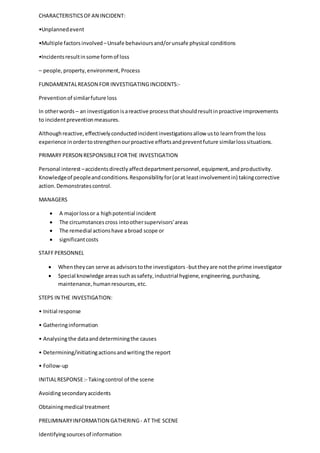Incident investigation techniques
•Descargar como DOCX, PDF•
0 recomendaciones•659 vistas
Denunciar
Compartir
Denunciar
Compartir

Recomendados
Recomendados
Más contenido relacionado
La actualidad más candente
La actualidad más candente (20)
Safety hazard-identification-on-construction-projects

Safety hazard-identification-on-construction-projects
PECB Webinar: Occupational Hazard Identification Risk Assessment and Risk Con...

PECB Webinar: Occupational Hazard Identification Risk Assessment and Risk Con...
Construction Safety Training_Session 10_Risk Assessment, Hierarchy of Control...

Construction Safety Training_Session 10_Risk Assessment, Hierarchy of Control...
Ppt for IMPROVEMENT OF SAFETY THROUGH SAFETY MANAGAMENT PLAN – office p...

Ppt for IMPROVEMENT OF SAFETY THROUGH SAFETY MANAGAMENT PLAN – office p...
Session 03_Risk Assessment Program for YSP_Risk Identification

Session 03_Risk Assessment Program for YSP_Risk Identification
Risk Assessment Program For Young Safety Professionals (YSP)

Risk Assessment Program For Young Safety Professionals (YSP)
Various steps of risk assessment. md. anwar ibrahim miraz

Various steps of risk assessment. md. anwar ibrahim miraz
Session 08_Risk Assessment Program for YSP_Risk Treatment and Communication

Session 08_Risk Assessment Program for YSP_Risk Treatment and Communication
Destacado
Destacado (17)
Similar a Incident investigation techniques
Similar a Incident investigation techniques (20)
1- Tripod Beta Analysis, Incident Reporting & Investigation Techniques.pptx

1- Tripod Beta Analysis, Incident Reporting & Investigation Techniques.pptx
PECB Webinar: Hazard Identification, Risk Assessment and Determining Controls...

PECB Webinar: Hazard Identification, Risk Assessment and Determining Controls...
Más de Salim Solanki
Más de Salim Solanki (20)
General safety precautions for maintenance of extinguisher

General safety precautions for maintenance of extinguisher
Do's & dont's tool box talk -safety subject wise 

Do's & dont's tool box talk -safety subject wise
Potential health hazard associated with handling pipe used in oil and gas pro...

Potential health hazard associated with handling pipe used in oil and gas pro...
Design and installation of fixed foam fire extinguishing system

Design and installation of fixed foam fire extinguishing system
Incident investigation techniques
- 1. CHARACTERISTICSOFAN INCIDENT: •Unplannedevent •Multiple factorsinvolved –Unsafe behavioursand/orunsafe physical conditions •Incidentsresultinsome formof loss – people,property,environment, Process FUNDAMENTALREASON FOR INVESTIGATINGINCIDENTS:- Preventionof similarfuture loss In otherwords – an investigationisareactive processthatshouldresultinproactive improvements to incidentpreventionmeasures. Althoughreactive,effectivelyconductedincidentinvestigationsallow usto learnfromthe loss experience inordertostrengthenourproactive effortsandpreventfuture similarlosssituations. PRIMARY PERSON RESPONSIBLEFORTHE INVESTIGATION Personal interest –accidentsdirectlyaffectdepartmentpersonnel,equipment,andproductivity. Knowledgeof peopleandconditions.Responsibilityfor(orat leastinvolvementin) takingcorrective action.Demonstratescontrol. MANAGERS A majorlossor a highpotential incident The circumstancescross intoothersupervisors'areas The remedial actionshave abroad scope or significantcosts STAFFPERSONNEL Whentheycan serve as advisorstothe investigators -buttheyare notthe prime investigator Special knowledge areassuchassafety,industrial hygiene,engineering,purchasing, maintenance,human resources,etc. STEPS IN THE INVESTIGATION: • Initial response • Gatheringinformation • Analysingthe dataanddeterminingthe causes • Determining/initiatingactionsandwriting the report • Follow-up INITIALRESPONSE:- Takingcontrol of the scene Avoidingsecondaryaccidents Obtainingmedical treatment PRELIMINARYINFORMATION GATHERING- AT THE SCENE Identifyingsourcesof information
- 2. Note yoursurroundings;peoplepresent;environmental conditions(light,noise,heat,cold,etc.); positionof materials, toolsandequipment;anythingoutof the ordinary Preserve the scene Protectionof the areafrom alterationasmuchas possible,ensurerequirednotificationsare made and gatherinformationquicklyandcompletely. Be a sponge GATHERING INFORMATION:- It isimportantto distinguishbetweenFACTandOPINION andunderstandthe role BOTHplayinthe investigation Dependingonthe emotionalstate of those involved - Interview eye witnessesfirst,thensecondary witnesses TIPSON CONDUCTINGINTERVIEWS:- Interviewseparately • Interviewinanappropriate place,on-site(if notdangerous oruncomfortable)orina private area. Officesmay appeartoomuch like interrogation/crossexamination. • Putthe personat ease - assure themthat the missionis "fact"findingtopreventarecurrence. • Avoidintimidatingvoice andbodylanguage. • Getthe individual'sversion Avoidinterrupting Don't put wordsintheirmouth Don't make judgmental statementslike "thatwas sure a dumbthingto do." Don't ask leadingquestionsandavoidyes-noquestions. • Give the witnesssome feedback.Repeatinformationto ensure understandingandprovide a chance for correction. Thiscreates"active"listeningonthe partof bothparties. • Use visual aids(sketches,digital photos). • End ona positive note.Thankthemfortheirtime and effort.Asktheirideas onhow thissituation couldbe preventedinthe future.Keepthe line open. INFORMATION GATHERINGFROMOTHER SOURCES:- Dependingon the situation,othersourcesof informationmaybe helpful,suchas: - TrainingRecords - Maintenance records(repairandPM) - Safetyinspectionreports - JHA,JSA , JSP andMOC documents - Changesinproductionschedule,materials,toolsandequipment - Special testingsuchasMaterial Failure Analysis
- 3. - Drawingsandphotos* Note:If you use photography(stillorvideo) be sure tophotographfromall anglesandprovide scale reference. EVALUATION OFDATA ANDIDENTIFICATION OFCAUSES(ROOTCAUSE ANALYSIS) :- - Immediate causes(symptoms) - Basiccauses(the why) "CARELESSNESS"ISNOT AN ACCEPTABLEREASON FOR "WHY" AN ACCIDENTHAPPENED. WE SHOULD ASK"WHY" WASTHE PERSON "CARELESS". SUMMARY: Effective incidentinvestigations:- Determine what“really”happenedratherthantry andprove what we “think”happened. Provide anassessmentof the losspotential associatedwiththe event(Risk). Provide the informationnecessarytostrengthenourproactive preventiveprogramcontrols(PRE- CONTACTSTAGE) andassistin improvingourlossminimization controls(“Damage Control”– CONTACTSTAGE). Define incidenttrends Demonstrate concernandimprove perception
